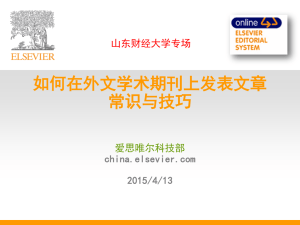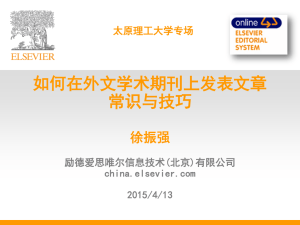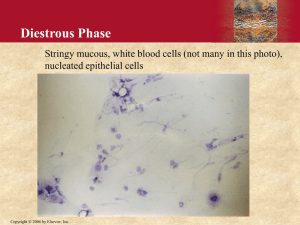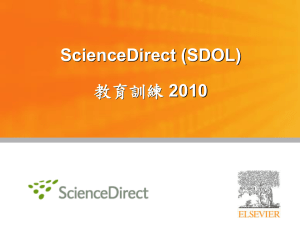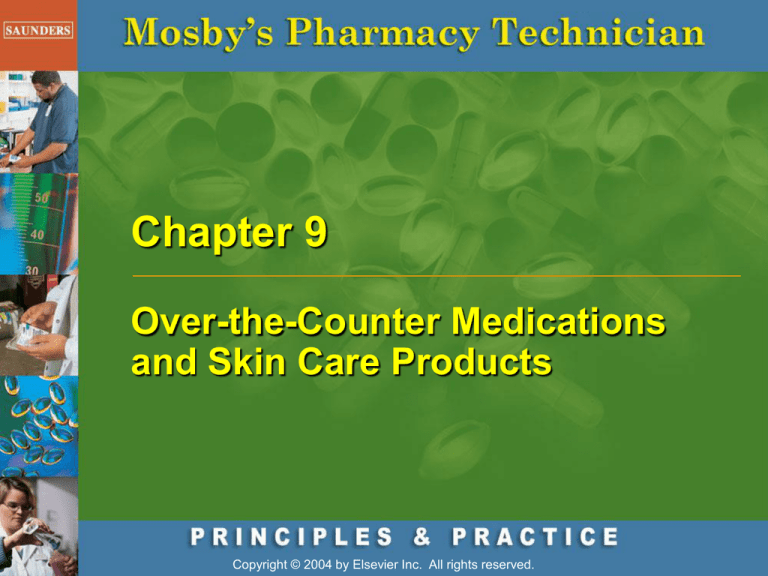
Chapter 9
Over-the-Counter Medications
and Skin Care Products
Copyright © 2004 by Elsevier Inc. All rights reserved.
Introduction
• OTC medications–no prescriptions
necessary
• Drugs–common staples in home
medicine cabinet
• Acetaminophen (Tylenol), cough syrup,
Ibuprofen (Motrin)
• OTC drugs–50% medication purchased
Copyright © 2004 by Elsevier Inc. All rights reserved.
Introduction
• It is important that consumers learn
about appropriate dosages and proper
use of these medications
• Pharmacists need to know what OTC
medications are being taken
• Patients need to know what to avoid
• Buying drugs OTC–substantial savings
Copyright © 2004 by Elsevier Inc. All rights reserved.
Introduction
• Consumers use OTC products:
– To save money
– To be involved in their
own treatment
– Because they are more
readily available
Copyright © 2004 by Elsevier Inc. All rights reserved.
Over-the-Counter Drug
Considerations
• Wide variety of drugs
• Identify the cause of the problem
• Misuse of drugs–contribute to
hospital stays
• Expiration dates need to be checked
• Tamper-proof packaging needs to
be checked
Copyright © 2004 by Elsevier Inc. All rights reserved.
Over-the-Counter Drug
Considerations
• Dosages for children under 2 years
not recommended
• Many OTC medications have identical
ingredients
• Manufacturers swap “like ingredients”
without notifying the customer.
The label will show the change
Copyright © 2004 by Elsevier Inc. All rights reserved.
Over-the-Counter Drug
Considerations
• No adverse reaction reports required
• Patients with special diets, allergies,
diabetes, and other medications need
to exercise caution
• Extra care for babies and young
children when purchasing
Copyright © 2004 by Elsevier Inc. All rights reserved.
Three Categories of OTC Drugs
• FDA classification:
– Safe and effective for claimed
therapeutic indication
– Not recognized as safe and effective
– Additional data must determine
whether safe and effective
Copyright © 2004 by Elsevier Inc. All rights reserved.
FDA Regulations
• Five major safety areas:
– Purity
– Potency
– Bioavailability
– Efficacy
– Safety and toxicity
Copyright © 2004 by Elsevier Inc. All rights reserved.
Purity
• Purity of a product represents the lack
of contamination from environmental
factors of the chemical (drug)
contained in the product
• Additives include fillers, dyes,
solvents, buffers, and waxes
• Various ingredients increase the
size of the medication, decrease
absorption, improve taste
Copyright © 2004 by Elsevier Inc. All rights reserved.
Potency
• Refers to the strength of the drug
• Measurement done in grams,
milligrams, or micrograms
• Drug tested on research animals
• Strength measured in units
Copyright © 2004 by Elsevier Inc. All rights reserved.
Bioavailability
• Level at which a drug is both absorbed
and transported to the site of action
• Measured by the concentration of the
drug in the blood or tissue at the peak
time of administration
Copyright © 2004 by Elsevier Inc. All rights reserved.
Efficacy
• The ability of the drug to produce the
desired chemical change in the body
• Clinical trials judge effectiveness
• Variances affect end results
• Variance–unknown health conditions,
age, weight, lifestyle, gender, and
genetic influences
Copyright © 2004 by Elsevier Inc. All rights reserved.
Safety and Toxicity
• Represent opposite effects of a drug
being studied
• Lab animals used as test subjects in
beginning stages of trials
• Later years, published results include
effects of drugs on pregnancy
Copyright © 2004 by Elsevier Inc. All rights reserved.
Safety and Toxicity
• Any drug can be toxic if not taken
correctly
• Difference between toxic and desirable
effects documented
• Difference “margin of safety”
• Drug falls into “margin of safety” is
“therapeutic dose”
Copyright © 2004 by Elsevier Inc. All rights reserved.
How a Prescription Becomes
an OTC Drug
• Amount of research extensive
• FDA approves all new drugs entering
the marketplace
• FDA uses three phases of testing
• Monograph gives information about
a drug
Copyright © 2004 by Elsevier Inc. All rights reserved.
3 FDA Phases
OTC Drug Approval
• Phase 1: Advisers evaluate agent for
safety and efficacy
• Phase 2: Final review done on
ingredients
• Phase 3: After evidence presented
and all aspects of the agent
are exhausted, the final
monograph is published
Copyright © 2004 by Elsevier Inc. All rights reserved.
How a Prescription
Becomes an OTC Drug
• Agent meets criteria–approved as
an OTC drug
• Some legend drugs become
OTC– strength is lowered
• Legend Ibuprofen
(400 mg, 600 mg, 800 mg)
• OTC Ibuprofen (200 mg)
Copyright © 2004 by Elsevier Inc. All rights reserved.
How a Prescription
Becomes an OTC Drug
• FDA in charge of recalls
• Manufacturers must show consistency
between batches of drugs on a
day-to-day basis
• OTC drugs can be taken off the
market if not consistent
Copyright © 2004 by Elsevier Inc. All rights reserved.
Conditions Treated with
OTC Drugs
• Table 9.2 in the textbook lists the
most common OTC medications
with symptoms treated and route
of administration
Copyright © 2004 by Elsevier Inc. All rights reserved.
OTC Agents–Patient Information
• Analgesics and Antipyretics–help
reduce or relieve pain and fever
• Aspirin–antiinflammatory agent;
decreases platelets; prophylaxis to
decrease risk of blood clotting in
heart disease and stroke
• Associated with Reye’s syndrome
Copyright © 2004 by Elsevier Inc. All rights reserved.
Antiinflammatories
• Nonsteroidal antiinflammatory drugs
(NSAIDs)–treat inflammation
• Reduce pain
• Used as antipyretic and analgesic
• May cause drowsiness, upset stomach;
take with food or milk
Copyright © 2004 by Elsevier Inc. All rights reserved.
Analgesics
and Antipyretic Products
Condition
Product
Dosage Forms
Fever/pain
Acetaminophen
(Tylenol)
Tab, cap,
liq supp
Fever/pain
Aspirin (Bayer,
Alka-Seltzer)
Tab, cap,
powder
Fever/pain
Ibuprofen (Motrin)
Tab, cap, liq
Pain/arthritis
Capsaicin (Zostrix)
Top
Tab, Tablet; cap, capsule; liq, liquid; top, topical; supp, suppository.
Copyright © 2004 by Elsevier Inc. All rights reserved.
Allergy and Cold Agents
• Relief of common cold–decongestants
and antihistamines
• Decongestants dry out membranes,
open airways, cause vasoconstriction,
reduce congestion
• Antihistamines–used with allergic
symptoms; action blocks histamine
(H-1) that causes allergic reaction
Copyright © 2004 by Elsevier Inc. All rights reserved.
Decongestant Products
Condition
Product
Dosage Forms
Common
cold/allergies
Oxymetazoline
(Afrin)
Spray
Phenylephrine
(Neo-Synephrine)
Spray
Normal saline
(Ocean)
Spray
Pseudoephedrine*
(Sudafed)
Clemastine (Tavist)
Tab, cap, liq
Common cold
Tab, liq
Tab, Tablet; cap, capsule; liq, liquid.
*Pseudoephedrine (Sudafed) is a decongestant and is less likely to cause
drowsiness. It is used exclusively as a decongestant, not for allergies.
Copyright © 2004 by Elsevier Inc. All rights reserved.
Antihistamine Products
Condition
Product
Dosage Forms
Congested
Chlorpheniramine
(Chlor-Trimeton)
Tab, cap nose,
Diphenhydramine
(Benadryl)
Tab, cap, liq
Loratadine
(Claritin)
Tab, cap
sinus
Tab, Tablet; cap, capsule; liq, liquid.
*These agents also come in many combinations with agents that treat cough,
fever, and pain.
Copyright © 2004 by Elsevier Inc. All rights reserved.
Antihistamines
• First-generation–common side effect
is sleepiness
• Second-generation–require a
prescription
• May cause drowsiness
Copyright © 2004 by Elsevier Inc. All rights reserved.
Decongestants
• Indicated for stuffiness and congestion
of nasal passages and sinuses
• Acts to open passages and allow release
of mucus
• Used for chest congestion–permits
coughing up of phlegm
• Available in both OTC and prescription
preparations
Copyright © 2004 by Elsevier Inc. All rights reserved.
Headache Products
• Analgesics
• Some contain additives–caffeine
• Migraines–prescription drug required
Copyright © 2004 by Elsevier Inc. All rights reserved.
Headache Products
Condition
Product
Severe
headache/migraine
ASA/caffeine/
acetaminophen
combination (Excedrin)
Dosage Forms
Tab
Caplet
ASA/calcium
carbonate combination
(Bayer Women's Aspirin
Plus Calcium)
Acetaminophen/
caffeine combination
(Excedrin Tension
Headache [aspirin free])
ASA, Acetylsalicylic acid (aspirin); tab, tablet.
Copyright © 2004 by Elsevier Inc. All rights reserved.
Caplet
Interactions Between
Aspirin and Other Agents
• Table 9.8 in the textbook lists
common interactions
• Pharmacist alerted by technicians
about interactions
Copyright © 2004 by Elsevier Inc. All rights reserved.
Sleep Aid
• Diphenhydramine or magnesium
salicylate used to treat insomnia
• Anti-Insomnia products are listed in
Table 9.9 in the textbook
• Diphenhydramine–most commonly
prescribed agent ordered in hospitals
for sleep
Copyright © 2004 by Elsevier Inc. All rights reserved.
Sleep Aid
• May cause drowsiness
• Avoid alcoholic beverages
• Do not use if suffering with asthma,
glaucoma, emphysema, or an enlarged
prostate
Copyright © 2004 by Elsevier Inc. All rights reserved.
Cough
• Largest OTC section–cold and flu
• Congested coughs–expectorants
• Dry nonphlegm-producing coughs–
suppressant
• Do not use if suffering with asthma,
glaucoma, emphysema, heart
problems, or an enlarged prostate
Copyright © 2004 by Elsevier Inc. All rights reserved.
Cold and Cough Products
Condition
Product
Dosage Forms
Congested cough
Guaifenesin/
pseudoephedrine
(Robitussin PE)
Tab, liq, syr
Guaifenesin
(Robitussin)
Tab, cap, syr
Guaifenesin/
dextromethorphan
(Robitussin DM)
Liq, syr
Dry cough
Tab, Tablet; liq, liquid; syr, syrup; cap, capsule.
Copyright © 2004 by Elsevier Inc. All rights reserved.
Sore Throat Products
• Cold or flu–causes of sore, scratchy,
and dry throats
• Sore throat–can be symptom of Strep
throat (treat with antibiotics)
• Syrups and sprays–relieve throat pain
• Phenol, Menthol, alcohol, and
benzocaine
Copyright © 2004 by Elsevier Inc. All rights reserved.
Sore Throat Products
Condition
Product
Dosage Forms
Sore throat
Benzocaine
(Chloraseptic)
Lozenges
Dyclonine HCl
(Cepacol)
Lozenges
Dyclonine/alcohol
(Sucrets)
Lozenges
Copyright © 2004 by Elsevier Inc. All rights reserved.
Stomach Remedies
• Common upset stomach remedies
• Histamine-2 (H2) antagonists–decrease
acid secretions (heartburn)
• Proton pump inhibitors–relieve acid
secretions
Copyright © 2004 by Elsevier Inc. All rights reserved.
Stomach Products/Antacids
Condition
Heartburn
Antacids
Product
Cimetidine
(Tagamet-HB)
Ranitidine
(Zantac-75)
Famotidine
(Pepcid-AC)
Nizatidine
(Axid-AR)
Calcium hydroxate
(Tums)
Aluminum
hydroxide/magnesium
hydroxide/simethicone
(Mylanta)
Tab, Tablet; liq, liquid.
Copyright © 2004 by Elsevier Inc. All rights reserved.
Dosage Forms
Tab, liq
Tab
Tab
Tab
Chewable tab
Tab, liq, gelcap
Stomach Remedies
• Antacid agents–used to balance
pH level of the stomach
(decrease heartburn)
• Taken for short-term relief
of heartburn
Copyright © 2004 by Elsevier Inc. All rights reserved.
Intestinal Remedies
• Intestinal discomfort–constipation,
diarrhea, gas (flatulence)
• Intestinal products contain oil or
saline solution
• Diarrhea–anticholinergic agent, fiber
Copyright © 2004 by Elsevier Inc. All rights reserved.
Intestinal Products
Condition
Product
Dosage Forms
Constipation
Combination
stimulant (Ex-Lax)
Tab, chew tab
Docsuate sodium
(Colace)
gelcap
Loperamide
(Imodium A-D)
Tab, cap, liq
Stool softeners
Diarrhea
Flatulence
Simethicone
(Mylicon)
Irregular bowels
Psyllium
(Metamucil)
Tab, Tablet; cap, caplet; liq, liquid.
Copyright © 2004 by Elsevier Inc. All rights reserved.
Tab, chew tab,
liq
Powder
Intestinal Remedies
• Loperamide, Metamucil
• Most commonly used gas treatment–
simethacone (Gas-X)
• Laxatives–do not use if abdominal
pain, nausea, and vomiting are present
• Loperaminde–may cause drowsiness
or dizziness
Copyright © 2004 by Elsevier Inc. All rights reserved.
Skin Anatomy
• Skin–integumentary system, largest
organ in the body
• Includes–skin, hair, subcutaneous
tissues
• One of the most abused organs
in the body
• Protects the body, regulates
temperature, is a sensor or stimuli
Copyright © 2004 by Elsevier Inc. All rights reserved.
Skin Anatomy
• Keratin–top layer of skin; for protection
• Epidermis and dermis–layers beneath
keratin
• Below dermis–subcutaneous layer
of fat
• Epidermis–no blood flow of its own
Copyright © 2004 by Elsevier Inc. All rights reserved.
Skin Anatomy
• Dermis–much thicker; holds nerves,
blood vessels, and other connective
tissue
• Skin–can absorb moisture and
medications
• Diabetics–inject insulin subcutaneously
• Intradermal route–between the
dermis layer
• Intramuscular–into the muscle layer
Copyright © 2004 by Elsevier Inc. All rights reserved.
Anatomy of the Skin
Epidermis
Dermis
Adipose
Tissue
Copyright © 2004 by Elsevier Inc. All rights reserved.
Hypodermis
Conditions Affecting the Skin
• Common dosage forms and types
of conditions they treat are listed
in Table 9.14 in the textbook
Copyright © 2004 by Elsevier Inc. All rights reserved.
Skin Disorders and Medications
• Proper diagnosis–physical
assessment, family history, drug
history, lab tests, possible biopsy
• Two very common skin conditions–
sunburn and acne
Copyright © 2004 by Elsevier Inc. All rights reserved.
Sunscreen Skin
Protectant Factor
• SPF agents–topical form; prevent
sunburn
• UVA rays and UVB rays–two main
wavelengths of rays that cause
concern
• UV rays–cause premature aging,
changes in the DNA, erythema,
and blistering
Copyright © 2004 by Elsevier Inc. All rights reserved.
Sunscreen Skin
Protectant Factor
• Overexposure to the sun can cause
mutations in DNA
• Cancer can occur and discoloration
of prematurely aged skin
• Melanin–chemical for skin color
Copyright © 2004 by Elsevier Inc. All rights reserved.
Sunscreen Skin
Protectant Factor
• Two types of protectants:
– Sunscreens–protect from UVA
and UVB rays
– Sun blocks–reflect UV rays
• SPF factor important
• Choose coverage based on skin types
Copyright © 2004 by Elsevier Inc. All rights reserved.
Skin Protectant Factor Guide
for Application of Sunscreen
Skin Type
I
Skin Characteristics
After 10 Min Sun Exposure
Burns easily/rarely tans
Suggested
Minimum Coverage
20 to 30 SPF
II
Burns easily/tans minimally
12 to 20 SPF
III
Burns moderately/tans gradually
8 to 12 SPF
IV
Burns minimally/tans well
4 to 8 SPF
V
Rarely burns/always tans
2 to 4 SPF
VI
Never burns/deeply pigmented
None
SPF, Skin protectant factor.
Copyright © 2004 by Elsevier Inc. All rights reserved.
Acne Development
and Treatment
• Acne affects teenagers and adults
• Caused by hormonal changes and
genetics
• Hormones enlarge the glands of
the skin
Copyright © 2004 by Elsevier Inc. All rights reserved.
Acne Development
and Treatment
• Two productive glands:
– Sweat: regulate temperature
– Sebaceous: produce skin oil
or sebum
• Increased sebum traps bacteria
• Keep skin clean and free from bacteria
Copyright © 2004 by Elsevier Inc. All rights reserved.
Acne Development
and Treatment
• Acne classified into two groups:
– Noninflammatory–treatment is
mild medication (keratolytics)
– Inflammatory–Benzoyl peroxide
most common OTC product
recommended
Copyright © 2004 by Elsevier Inc. All rights reserved.
Acne Development
and Treatment
• Antibiotics used–tetracycline,
erythromycin, clindamycin
• Topical Agents–retinoic acid,
isotretinoin (Accutane), and tretinoin
(Retin A)
Copyright © 2004 by Elsevier Inc. All rights reserved.
Miscellaneous Skin Conditions
• Two categories:
– Noninfectious inflammatory
conditions
– Infectious inflammatory conditions
• See physician for persistent symptoms
Copyright © 2004 by Elsevier Inc. All rights reserved.
Hives/Inflammation
• Common noninfectious conditions
include: urticaria (hives), eczema
(red skin rash), psoriasis (plaques,
scaly skin), seborrheic dermatitis
(rash), and atopic dermatitis (rash)
• Topical agents: used for hives and
skin rashes causing inflammation
from severe itching
• Psoriasis: consult a doctor
Copyright © 2004 by Elsevier Inc. All rights reserved.
Infectious Inflammatory
Skin Conditions
• Warts–viral, contagious
(See Table 9.18 in the textbook)
• Genital warts–see doctor
• Athlete’s foot–caused by fungus; treat
with powdered antibiotics
(See Table 9.19)
• Canker sores–inside cheek of mouth;
small topical ulcers (See Table 9.20)
Copyright © 2004 by Elsevier Inc. All rights reserved.
Topical Antibiotics
• Used to treat abrasions, small cuts,
and scrapes
• Clean wound properly
• See the list of agents for treating
such wounds on the next slide
Copyright © 2004 by Elsevier Inc. All rights reserved.
Antibiotic Products
Product
Trade Names
Dosage Forms
Bacitracin
Bacitracin
Oint
Neomycin
Neomycin
Oint
Myciguent
Cream
Neosporin
Oint, cream
Polymyxin B,
neomycin,
bacitracin
Oint, Ointment.
Copyright © 2004 by Elsevier Inc. All rights reserved.
Psoriasis
• Genetic skin condition; cannot be
cured; lasts a lifetime
• Not contagious but looks bad
when inflamed
• Most affected areas: joints, limbs,
neck, scalp
• Potent drugs used: corticosteroids
(require physician’s prescription)
• Sunlight treatments
Copyright © 2004 by Elsevier Inc. All rights reserved.


